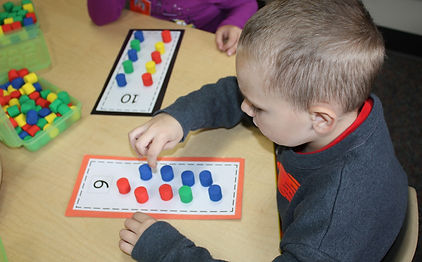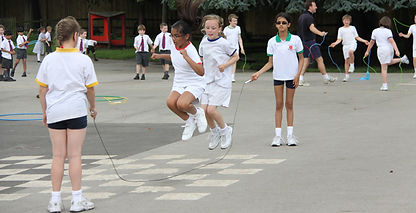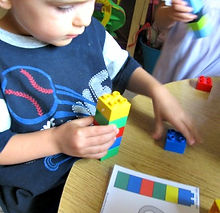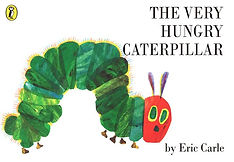One-to-One Correspondance

Children need to 'see the link between the order in which we say the number names and the size of collections’
(DOE, 2013, p. 88)
One-to-one correspondence is a key skill which is learnt in the early years of children’s education which allows them to ‘systematically count a collection’ (Department of Education, 2013, p. 86). One-to-one correspondence is an explicit understanding that one item counted within a collection can be abstracted into the number 1 and that number equates to one item within a collection. A second item counted within a collection is abstracted into the number 2 and that this number relates to both items in the collection but the object counted is still one item within a group of 2. Knowing that ‘4 is the number between 5 and 3 as well as 1 more than 3 and 1 less than 5’ (Reys et al., 2012, p. 149).
Key Understanding 1 - we can count a collection to find out how many are in it - of First Steps in Mathematics: Number Book 1 – outlines the importance of one-to-one correspondence while identifying that ‘most children are likely to learn ‘to count’ in the sense of chanting the number names in order and then learn to count a collection by 1-1 matching of the number names in order with the items’. This ensures ‘that children see the link between the order in which we say the number names and the size of collections’ (DOE, 2013, p. 88). Five principles are listed as vital components that children need to internalise when counting collections in order for them to accept the count as fact. These principles include: ‘each object to be counted must be touched or ‘included’ exactly once as the numbers are said; the numbers must be said once and always in the conventional order; the objects can be touched in any order, and the starting point and order in which the objects are counted does not affect how many there are; the arrangement of the objects does not affect how many there are; the last number said tells ‘how many’ in the whole collection. It does not describe the last object touched’ (DOE, 2013, p. 12). These skills may not all be learned at one time and instead may be developed over different stages as a student's mathematical reasoning develops and they accept the count as fact.
The Australian Curriculum
The Australian Curriculum’s (Australian Curriculum, Assessment & Reporting Authority, 2014) foundation mathematical content recognises the importance of one-to-one correspondence and elements of this concept feature heavily under the number and place value content strand. Listed below are these relevant content descriptions.
Australian Curriculum – Maths:
-
Number and Algebra – Number and Place Value: Establish understanding of the language and processes of counting by naming numbers in sequences, initially to and from 20, moving from any starting point (ACMNA001). Elaborations: identifying the number words in sequence, backwards and forwards, and reasoning with the number sequences, establishing the language on which subsequent counting experiences can be built; developing fluency with forwards and backwards counting in meaningful contexts, including stories and rhymes; and understanding that numbers are said in a particular order and there are patterns in the way we say them.
-
Number and Algebra – Number and Place Value: Connect number names, numerals and quantities, including zero, initially up to 10 and then beyond (ACMNA002). Elaborations: understanding that each object must be counted only once, that the arrangement of objects does not affect how many there are, and that the last number counted answers the ‘how many’ question.
-
Number and Algebra – Number and Place Value: Compare, order and make correspondences between collections, initially to 20, and explain reasoning (ACMNA289). Elaborations: comparing and ordering items of like and unlike characteristics using the words ‘more’, ‘less’, ‘same as’ and ‘not the same as’ and giving reasons for these answers; understanding and using terms such as ‘first’ and ‘second’ to indicate ordinal position in a sequence.
The Australian Curriculum recognises that ‘numeracy is an essential skill for students in becoming successful learners at school and in life beyond school’ (ACARA, 2014). It is therefore only fitting that numeracy is listed as one of the over-arching general capabilities which are designed to address ‘essential skills for twenty-first century learners’ (ACARA, 2014). The organising elements for the General Capability: Numeracy includes: calculating with whole numbers. One-to-one correspondence is the building block and a foundational stage for children when developing counting skills.
The Early Years Learning Framework for Australia
The Early Years Learning Framework (EYLF) for Australia incorporates elements and skills associated with one-to-one correspondence heavily in Outcome Five: Children are Effective Communicators. Under the sub-heading, children interact verbally and non-verbally with others for a range of purposes, the EYLF have included the ‘use (of) language to communicate thinking about quantities to describe attributes of objects and collections, and to explain mathematical ideas’ (2009, p. 40). Under the sub-heading, children engage with a range of texts and gain meaning from these texts, the EYLF have acknowledged that children in the early years should be ‘begin(ing) to understand key … numeracy concepts and processes’ (2009, p.41). Under the sub-heading, children begin to understand how symbols and pattern systems work, the EYLF acknowledge that children in their early years of schooling should begin to ‘sort, categorise, order and compare collections and events and attributes of objects and materials, in their social and natural worlds’ (2009, p. 43). In order to promote this kind of learning within a classroom, teachers need to ensure they ‘provide children with access to a wide range of everyday materials that they can use to create patterns and to sort, categorise, order and compare’ while promoting ‘children’s use of mathematical language’ (EYLF, 2009, p. 40-43).
Activity Ideas
Ideas to incorporate one-to-one correspondence into an early childhood setting would be to include a number of open-ended provocations/activities which aim to intentionally promote this particular mathematical thinking. Pinterest (2014) contains a number of great provocation type activates that promote one-to-one correspondence. These activities could be set up in a classroom for children to explore independently. I particularly like the tree activity. The cut-out leaves could be replaced with real leaves to create a more authentic and engaging task. Click on the images below to view some of these activities in more detail.
Other great ideas to incorporate one-to-one correspondence within an early childhood classroom might be to encourage counting. The next time the children are playing outside you can encourage them to count what they are doing. I have seen this work particularly well when counting the number of skips someone can do with a skipping rope before losing their rhythm. The next minute I had a number of children grab skipping ropes and try to beat the original score, all counting their own skips. This could be incorporated into bouncing a ball. Utilise questions such as: How many times can you bounce the ball? How many more bounces can you do?Building blocks are another great way to instigate one-to-one correspondence. In the past I have seen children create very tall constructions made from joining building blocks. With the right teacher encouragement and questioning, the children are only too happy to count the amount of pieces in their structure, to see who has more or less.
Recommended Children's Book
The Very Hungry Caterpillar - by Eric Carle
Eric Carle's The Very Hungry Caterpillar is a perennial favourite with
children and adults alike. Its imaginative illustration and clever cut-out
detail charts the progress of a very hungry caterpillar as he eats his
way through the week.
More Information
For more information on one-to-one correspondance please have a look at one of these informative YouTube videos below:
References
All Our Days. (2012). Building-a-Matching-Tower. [Image]. Retrieved 14/10/2014 from http://allourdays.com/2012/10/duplo-blocks-counting-tower-matching-busy-bag.html
Australian Children’s Education & Care Quality Authority. (2013) Guide to the national quality standard. Retrieved 13/10/2014 from http://files.acecqa.gov.au/files/National-Quality-Framework-Resources-Kit/NQF03-Guide-to-NQS-130902.pdf
Australian Curriculum Assessment and Reporting Authority. (2014). Australian curriculum. Retrieved 13/10/2014 from http://www.australiancurriculum.edu.au/
Australian Government Department of Education, Employment and Workplace. (2009). The early years learning framework for Australia: Belonging, being and becoming. Retrieved 13/10/2014 from http://files.acecqa.gov.au/files/National-Quality-Framework-Resources-Kit/belonging_being_and_becoming_the_early_years_learning_framework_for_australia.pdf
Department of Education. (2013) First Steps in Mathematics: Number Book 1. Retrieved from: http://www.det.wa.edu.au/stepsresources/redirect/?oid=com.arsdigita.cms.contenttypes.FileStorageItem-id-13683969&stream_asset=true
Farfield Preparatory School. (2012). skipping. [Image]. Retrieved 14/10/2014 from http://www.lesfairfield.org/about/news/general/sponsored-skipathon/
Laughing Kids Learn. (2014). colour-matching-and-counting. [Image]. Retrieved 14/10/2014 from http://laughingkidslearn.com/tag/one-to-one-correspondence/
Mrs Atkins Kindergarten. (2012). IMG_1462. [Image]. Retrieved 14/10/2014 from http://atkinkinder.blogspot.com.au/2012/09/work-stations-2-and-classroom-number.html
Penguin Books Australia. (2014). 9780140569322 (1). [Image]. Retrieved 14/10/2014 from http://www.penguin.com.au/products/9780140569322/very-hungry-caterpillar
Reys, R. E., Lindquist, M. M., Lambdin, D. V., Smith, N. L., Rogers, A., Falle, J., Frid, S., & Bennett, S. (2012). Helping Children Learn Mathematics (1st Ed.). Queensland, Australia: Wiley.
One-to-one correspondance and its importance in numeracy

One-to-one correspondence is a key skill which is learnt in the early years of children’s education which allows them to ‘systematically count a collection’
(DOE, 2013, p. 86)





